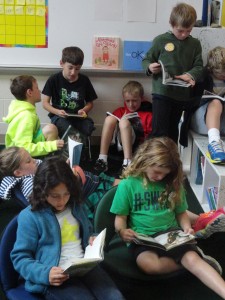 We’ve had a busy, fun week: Dot Day on Monday, Picture Day, and an outdoor challenge on Tuesday. Along with those things special things, we’ve been learning about scientific inquiry through Chromatography, exploring elements of personal narrative, and working to understand the relationship between multiplication and division. The children have continued reading a lot. They’ve been creating their own poems and stories, and learning about and practicing basic math facts. Above all of the content, we are continuing to learn about ourselves and exploring the habits individuals and groups need to achieve success.
We’ve had a busy, fun week: Dot Day on Monday, Picture Day, and an outdoor challenge on Tuesday. Along with those things special things, we’ve been learning about scientific inquiry through Chromatography, exploring elements of personal narrative, and working to understand the relationship between multiplication and division. The children have continued reading a lot. They’ve been creating their own poems and stories, and learning about and practicing basic math facts. Above all of the content, we are continuing to learn about ourselves and exploring the habits individuals and groups need to achieve success.
International Dot Day
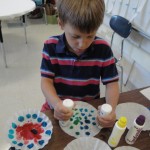
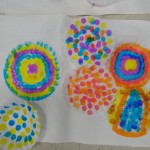
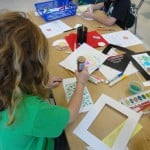
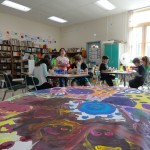
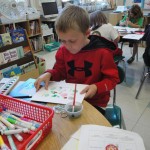
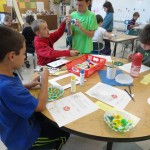 Inspired by Peter Reynold’s book The Dot, Dot Day is a celebration of perseverance, determination and growing self-confidence. It is fun, because just like Vashti who feels she can’t draw, we can all make a dot. We made colorful dots, window dots, and framed dots. We made dot pins, dot magnets and dot key chains. We made a class super dot and put them all in a class gallery.
Inspired by Peter Reynold’s book The Dot, Dot Day is a celebration of perseverance, determination and growing self-confidence. It is fun, because just like Vashti who feels she can’t draw, we can all make a dot. We made colorful dots, window dots, and framed dots. We made dot pins, dot magnets and dot key chains. We made a class super dot and put them all in a class gallery.
In the book Vashti’s dots are put on display and she is admired as a great artist. The boy who admires her work does not believe he can “draw a straight line with a ruler.” Vashti encourages him to make his mark and to see where it takes him. He does. We did too. If you are at the school some afternoon please come and tour our gallery in the hall outside our classroom. Together we make quite a mark. We had a fun day creating together.
The River Runner Challenge – Deepening Relationships
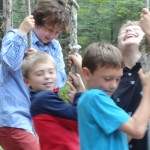

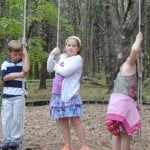
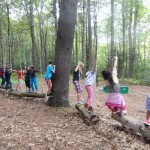
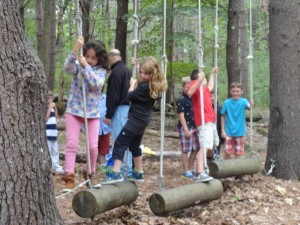 After a day of creating together, on Tuesday we went outside on the nature trail for another group learning experience. The class was able to challenge themselves in a physical way: could they cross over sections of swaying logs, pass around a tree and continue to the other end? Once that challenge was met, a cooperative element was added: could we divide the class in half and begin from either side, meeting in the middle, passing and reaching the opposite end? Of course all this had to happen without anyone falling off. That meant lots of talking, patience and encouragement. Once that challenge was met, an element of trust was added: could we cross the logs with eyes closed? And finally could we cross from either end in a blind challenge? Children were encouraged to open their eyes whenever they needed to feel safe and sure.
After a day of creating together, on Tuesday we went outside on the nature trail for another group learning experience. The class was able to challenge themselves in a physical way: could they cross over sections of swaying logs, pass around a tree and continue to the other end? Once that challenge was met, a cooperative element was added: could we divide the class in half and begin from either side, meeting in the middle, passing and reaching the opposite end? Of course all this had to happen without anyone falling off. That meant lots of talking, patience and encouragement. Once that challenge was met, an element of trust was added: could we cross the logs with eyes closed? And finally could we cross from either end in a blind challenge? Children were encouraged to open their eyes whenever they needed to feel safe and sure.
As an observer, I watched children try something they weren’t sure they could do. I saw them choose to give it a try. I saw them trust one another. I saw and heard great care for each other. There were encouragements, compliments and kind words spoken throughout the challenge. There was pride in work well done and happiness over the accomplishments of the whole group. It took focus, determination and real teamwork to meet all four levels of the challenge. 3E is coming together as a kind and strong learning community.
Knowing Ourselves – Social Emotional Learning
This week we began learning about the eight different intelligences defined in Multiple Intelligence (MI) theory. This is to begin thinking about how we are uniquely smart and how we best learn. We read different biographies and autobiographies to see if we could identify the ways these people were intelligent. There are some things we cannot know from the book, but the children had amazing thoughts as they explained how the stories shared evidence of the different ways these people were smart. We learned about Snowflake Bentley, Michael Jordan and Patricia Polacco. We will use this work as a springboard for identifying our own top intelligences. The most exciting thing we are learning of our ability to grow and change our intelligence. We can do anything we want to do with effort, determination, confidence and time (sometimes lots of time.)
Identifying Habits that Lead to Success
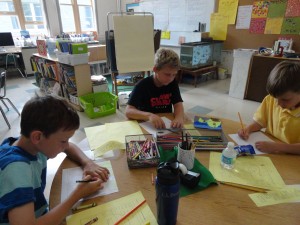 Along with learning about MI theory, we have been exploring different parts of school learning to establish a clear foundation of capabilities as the year begins. We have been talking about how our habits and choices help us achieve goals. We are all learners. We have noticed from our shared reading that most people don’t do things easily the first time. Learning something new doesn’t usually happen in a snap or the blink of an eye. People work at things for a long time – years and years even. Snowflake Bentley didn’t get one picture of a snowflake in his first year of trying. We have noticed successful people try in different ways and they have help, support and opportunity in order to achieve their goals. Patricia Polacco (children’s author and illustrator) didn’t read until she was in 5th grade – and she was teased about it mercilessly. We are trying to take notice of what we are thinking and what we are doing. By being more aware, we think we can become even stronger learners. We have more to think about with this as we figure out how we are smart and what we do to help ourselves learn.
Along with learning about MI theory, we have been exploring different parts of school learning to establish a clear foundation of capabilities as the year begins. We have been talking about how our habits and choices help us achieve goals. We are all learners. We have noticed from our shared reading that most people don’t do things easily the first time. Learning something new doesn’t usually happen in a snap or the blink of an eye. People work at things for a long time – years and years even. Snowflake Bentley didn’t get one picture of a snowflake in his first year of trying. We have noticed successful people try in different ways and they have help, support and opportunity in order to achieve their goals. Patricia Polacco (children’s author and illustrator) didn’t read until she was in 5th grade – and she was teased about it mercilessly. We are trying to take notice of what we are thinking and what we are doing. By being more aware, we think we can become even stronger learners. We have more to think about with this as we figure out how we are smart and what we do to help ourselves learn.
Chromatography – the science of color
Our science work thus far has been to help the children learn the steps of scientific inquiry and to develop the habit of noticing the “what – if” questions that pop up in our minds as we are working through different situations or encountering new materials.
Last week we put black lines on paper towels and placed them in cups of water. What would happen? Most children predicted that the towels would get wet. None of them predicted that the marker would bleed. They were excited to see the color run down through the water and even more excited to see blue come out of the black. This week we got to look closely at those strips of paper. We discovered that the lines were no longer black. They were blue and red, sometimes green and orange and even appeared a bit sparkly. We think water pushes the marker up and pulls the colors out because black is really made of all the colors mixed together.
Now come the “what -if” questions. Some of the children put several lines, at different heights on their paper towels, and yet the water never went beyond the first. Why? Will the same thing happen if we use other colors? Will all types of black markers separate into the same colors? What happens if we use something other than water like rubbing alcohol or ginger ale?
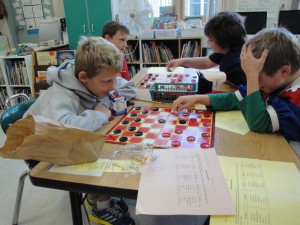 We’ll test out our questions and try to become more exact with our descriptions and our observations. We will work to become more precise in our predictions and more organized as we write our hypothesis and think about how even the most ordinary things can lead us to further and further investigation as we consider what’s next and what if.
We’ll test out our questions and try to become more exact with our descriptions and our observations. We will work to become more precise in our predictions and more organized as we write our hypothesis and think about how even the most ordinary things can lead us to further and further investigation as we consider what’s next and what if.
Bits and Pieces:
- We have begun our 3rd chapter read-aloud. It is the first in a new series called, The Quirks – Welcome to Normal. See if your child can tell you about the Quirk family and what they know so far. We are only a few chapters into the book, but the children have enough information to begin making predictions and to wonder how living in Normal, Michigan is going to work for this unusual family.
- The children are developing a firmer understanding of the concepts that related multiplication and division. Most of them are able to use both addition and multiplication to represent their math thinking. And most seem to be able to represent sets and groups to show their understanding of division.
- Several of the children have posted original poems in the collection of poems we read each day. A few of them have completed stories that they might consider publishing.